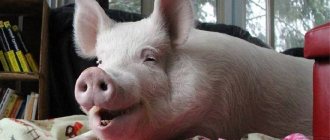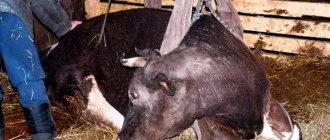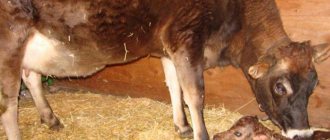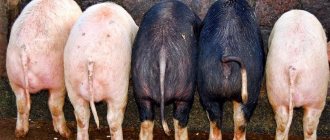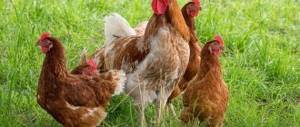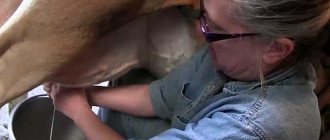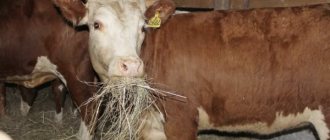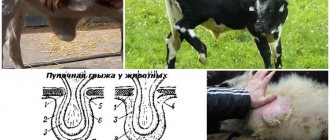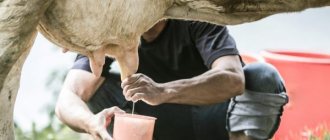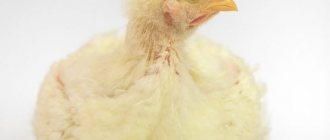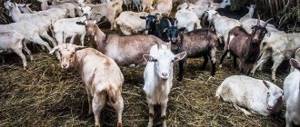How to solve the problem of teeth grinding in young animals
- No chewing gum
- White muscle disease
- Gastroenteritis
- Scar parakeratosis
If your calf grinds its teeth, you should consult a veterinarian, as the symptom may indicate either a minor disorder or a serious illness. Grinding or grinding of teeth in a calf can result from various reasons. Accurate diagnosis requires not only experience, but also laboratory tests. Teeth grinding may be caused by the following disorders or diseases.
Diagnosis of diseases
External symptoms may not be enough for a correct diagnosis. If the calf grinds its teeth more than once, laboratory tests need to be carried out. This is especially true if white muscle disease is suspected, when incorrect diagnosis and treatment or its absence can lead to the death of the individual.
To determine the pathology, blood and urine are taken from the bull for analysis. With white muscle disease, the number of red blood cells and protein will be less than normal, the creatine content in the urine will be increased, and the reaction will be shifted to the acidic side. If gastroenteritis is suspected, parasitic and infectious diseases with similar manifestations must be excluded.
See also
Symptoms and diagnosis of tuberculosis in cattle, treatment and vaccinationRead
White muscle disease
Scientists disagree on the causes of white muscle disease and name them as viruses, a lack of vitamins A and E, and a deficiency of microelements (in particular, selenium and cobalt).
Symptoms of the disease
Symptoms other than grinding include : general weakness up to the inability to stand up, stomach upsets and foul-smelling stool, cloudy eyes.
Course of the disease
White muscle disease is the occurrence of degenerative-dystrophic processes in muscle tissue. Fibers can be replaced by other types of tissue (fatty, connective) or completely destroyed.
Since a viral etiology cannot be excluded, if symptoms appear in one individual, it is extremely important to take care of the safety of the others.
Laboratory diagnostics
In the early stages, white muscle disease can easily be confused with other ailments without testing. There are frequent cases of the disease with blurred clinical signs. If animals do not receive timely and adequate treatment, mortality can reach 60-90%.
When diagnosing the disease, the following tests are performed (results indicating the presence of white muscle disease are indicated in parentheses):
- general blood test (decreased protein level, decreased red blood cell count);
- general urine analysis (presence of protein, sugar, increased amount of creatine, acid reaction).
Treatment
To treat white muscle disease, calves are prescribed subcutaneous or intramuscular vitamins E and A and selenium preparations. Selenium is usually given in the form of sodium selenite.
Treatment with this drug requires the participation of a specialist. Overdose can be fatal (sodium selenite is a hemolytic poison).
Severe abscesses often occur at the injection site, the prevention of which requires simultaneous use of antibiotics.
Gastroenteritis
In the vast majority of cases, the cause of gastroenteritis in young animals is nutritional disturbances.
Poor quality feed: rotted hay, stale skim milk, concentrates contaminated with fungi - all this causes gastric upsets.
Lack of variety in the diet leads to perversion of taste in calves. The young animals begin to chew soiled bedding, plaster, etc.
Symptoms of the disease
In addition to grinding teeth, during gastroenteritis calves experience diarrhea (including the presence of mucus and blood in the stool), lethargy, lack of appetite, and fever.
Laboratory diagnostics
It is important to exclude the possibility of other, more serious diseases, which is why laboratory diagnostics and tests are necessary.
Treatment
To treat gastroenteritis, it is necessary to cleanse the body, so for the first 1-1.5 days the calf is kept on a fasting regime, drinking only warm and slightly salted water as needed. After this, acidophilus milk, fresh skim milk, and oatmeal are gradually introduced into the diet. If symptoms are favorable, you can gradually switch to your usual diet, carefully monitoring the quality of the feed.
Why does a dairy cow grind her teeth?
Farmers raising livestock for sale and ordinary rural livestock breeders should always be attentive to their animals, the behavior of which may signal a health condition.
For example, it is important to understand why a cow clenches her teeth, and to do this, consult a veterinarian. If calves or cows begin to grind their jaws, this does not always mean illness. Periodically grinding teeth is normal for healthy young cattle or an adult cow, which is possible when soil or sand gets into the animal’s oral cavity with food. When individuals try to spit out debris, for example, to get rid of wire, nails, staples, the action of the jaws on the object produces a sound similar to a creaking or grinding sound.
Advice: Before giving the animal food, you should shake it and check for unnecessary contents.
When a cow begins to grind tooth against tooth, this may be a harbinger of one of several diseases with a similar symptom. For example, this is how the body sends a signal that it lacks vitamins or minerals. Or, when there is a change in taste preferences, the cow may eat plaster or bedding, which indicates a lack of certain substances, as a result of which it may creak.
Read also: Calving a cow: signs of twins
Tip: Harmless symptoms of grinding are easily eliminated. The cow's feed menu is reviewed, the inclusion of sand and other debris in the food is monitored, the cow is given more varied food, and anti-rickets preventive measures are also carried out.
Also, the reason why the cow began to grind its teeth could be gastroenteritis, white muscle and some other gastric and intestinal diseases.
A cow or heifer, if sick, may not only grind its jaw, but have a fever, the intestines will be upset, and there will be blood in the feces. This is how gastroenteritis can manifest itself. The cause of the disease is poor quality feed, rotted hay, food contaminated with spores of a pathogenic fungus. Even switching to a different feeding regime for calves or cows, intoxication and unsanitary living conditions can cause stomach illness, and restless cattle will grind their teeth.
If foam comes out of the mouth, this may indicate poisoning or stomatitis. When a cow coughs and begins to grind her jaw, she may have a cold; it is necessary to eliminate drafts and insulate the barn during the cold season.
Scar parakeratosis
This is a disease of the digestive system that affects calves up to 6 months of age. The main reason is dietary disturbances (excessive content of concentrates, carotene deficiency, lack of roughage).
Symptoms of the disease
In addition to grinding teeth , the calf may experience weak peristalsis, drooling, and unexpressed contractions of the rumen.
Laboratory diagnostics
Determining parakeratosis requires testing to detect an acidic environment in the rumen and increased histamine levels.
Treatment
In addition to normalizing the diet, to restore body functions, the calf is given vitamin A, burnt magnesia, and sodium bicarbonate.
Obviously, if a calf grinds its teeth, the reasons may be different; only a specialist can determine the exact diagnosis.
Causes
The causes of teeth grinding in a calf are a consequence of unsatisfactory maintenance and irrational feeding. The baby is born monogastric, and its formation as a ruminant animal occurs in the first two months of existence. If at this time the cub catches a cold and gets sick, or the development of the forestomach takes place under conditions of improper feeding, it will not be easy for him to resist numerous diseases, not necessarily of a contagious etiology. Every little thing matters:
- Feeding mothers moldy hay and concentrates affected by fungi, spoiled silage, leads to the calf receiving defective milk.
- Feeding the baby spoiled feed, or ingredients unusual for it - silage, coarsely cut hay or non-grade hay, concentrates with a large number of seed coats, lays the preconditions for the future ruminant animal to disrupt the functioning of the rumen.
- Low-quality diet ingredients destroy vitamins, bind minerals, or interfere with their absorption.
Scar parakeratosis
It is characterized by keratinization and atrophy of the scar papillae. The mucous membrane of the proventriculus becomes inflamed, the functioning of the microflora is disrupted. Occurs mainly in calves up to six months of age when the optimal ratio between roughage and concentrates is not observed in favor of the latter. The disease is becoming widespread among intensively fed young animals, aggravated by carotene deficiency and an increased need for zinc. Rapid fermentation of starch-containing substances leads to the synthesis of large amounts of carboxylic acids, and the pH of the rumen drops. Conditions become unfavorable for microflora, and some of them die. Peristalsis slows down, salivation, teeth grinding, tympany, dehydration, and tachycardia are observed.
The calf becomes lethargic, grows poorly, does not eat, but drinks. The diagnosis is made on the basis of anamnesis (diet analysis), clinical symptoms, studies of the contents of the rumen and blood, and postmortem examination of dead animals.
Lack of treatment can lead to death. What to do? The main treatment method is diet therapy, which consists of the following actions:
- Inclusion of good hay, rich in carotene, in the diet, while reducing the proportion of concentrates to less than 40% of dry matter.
- Give an injection of Trivitamin or another drug containing vitamin A.
- To raise the pH of the rumen to optimal values, drink a solution of baking soda or burnt magnesia.
- The diet includes a premix, which is a source of vitamins, as well as zinc and other minerals.
The calf has diarrhea and grinds his teeth
Monitoring calves in the first weeks after birth is important.
During this period, the formation of organs, systems and the body of a small calf takes place, and adaptation to the diet of a ruminant animal occurs. The proper development of the digestive tract is of great importance. When a calf grinds its teeth, the quality of the feed should be checked. Sometimes particles of soil or sand get on your teeth. In other cases, it may be an innate ruminant reflex in the absence of chewing food. If the calf grinds its teeth and does not eat anything, the problem lies in the pathology of the gastrointestinal tract.
In case of serious illnesses, when the help of a veterinarian is needed, teeth grinding is accompanied by other alarming symptoms:
- diarrhea;
- temperature;
- weakness;
- lack of appetite;
- foam at the mouth.
Grinding of teeth due to improper maintenance and poor nutrition can be a sign of parakeratosis of the rumen - stomach, gastroenteritis and white muscle disease - myopathy.
Due to the incorrect ratio of roughage and concentrates, a small calf experiences coarsening and atrophy of the papillae of the stomach walls, the balance of microflora is disturbed and the mucous membrane becomes inflamed. This is how scar parakeratosis manifests itself. Feeding young animals with starch-containing ready-made feeds with a small amount of carotene reduces the acidity of the rumen, which leads to the death of healthy microflora.
The calf has impaired peristalsis, drooling, dehydration, and tachycardia. The animal stops eating, drinking, and grows poorly. One of the leading symptoms of the disease is the calf grinding its teeth. Treatment should be aimed at restoring proper nutrition and relieving unpleasant symptoms with medications.
Lack of appetite, diarrhea, the calf grinds its teeth, lies down and does not get up - these are signs of gastroenteritis. Common causes: poisoning from missing food, toxic substances, expired products.
An animal in this condition needs detoxification, gastric lavage, and therapeutic fasting.
Under the supervision of a veterinarian, he is given medications to relieve spasms, remove toxins and restore digestion.
A lack of vitamins A and E, the microelement selenium, as well as a viral infection lead to white muscle disease. In this case, the red muscle fibers of calves are replaced by white adipose or connective tissue.
The disease is manifested by grinding teeth, general weakness, conjunctivitis, bloating, and foul-smelling diarrhea.
Therapeutic and preventive measures should be aimed at relieving symptoms and replenishing the required amount of nutrients.
When it is noticed that a calf is grinding its teeth, the disease can only be accurately determined by laboratory tests. Typically, the veterinarian prescribes diagnostic tests:
- blood analysis;
- Analysis of urine;
- determination of histamine level - with parakeratosis of the scar, the indicator is high.
The results of the blood test pay special attention to the content of protein and red blood cells. In white muscle disease, their number is less than normal. In the urine, the disease is confirmed by the acidic reaction of the medium and the presence of protein.
If an owner notices that one of his calves is grinding his teeth, the first thing he should do is check the feed for the presence of foreign substances or debris. The food must be balanced and of high quality. The diet should contain roughage, vitamins and probiotics.
A veterinarian's consultation is required. Initiating a disease is dangerous. All diseases accompanied by teeth grinding in calves, if left untreated, lead to death with a 90% probability.
To treat scar parakeratosis, medications are prescribed:
- injections of vitamin A preparations – “Trivitamin”, etc.;
- feed additives with zinc and other minerals and vitamins;
- sodium bicarbonate.
Gastroenteritis is treated with such ready-made remedies as:
- enterosorbents;
- antispasmodics;
- antimicrobial drugs.
Help against white muscle disease:
- subcutaneous or intramuscular injections of vitamins A, E;
- preparations containing selenium;
- antibiotics.
All medications are administered under the strict supervision of a specialist. Self-medication with selenium preparations is especially dangerous, because the difference between therapeutic and toxic doses is small.
Folk remedies help to quickly relieve unpleasant symptoms, but do not eliminate the disease. In case of gastroenteritis with its symptoms of poisoning, calves are fed rice or oatmeal broth, warm and salted water. Healthy microflora is restored with acidophilus milk and fresh skim milk.
In case of parakeratosis of the rumen, the acidity of the stomach is increased with a solution of soda or burnt magnesia. Increase the amount of hay in the calves’ diet and reduce the proportion of mixed feed. Feeding must meet the needs of the ruminant animal.
For preventive purposes, cows should be given vitamin and mineral complex supplements before and after calving. Feed mixtures, in addition to wheat and barley, must contain corn, beet pulp, cake, meal and a mixture of leguminous crops.
As calves grow, it is necessary to remove dairy products and transfer them to silage. They begin to mix hay into four-day-old calves. In areas with a deficiency of selenium, barn owners should always have preparations with this trace element on hand.
The process itself when a calf grinds its teeth is not dangerous. But this may be a sign of a serious illness that will not go away without the intervention of the owner and veterinarian. When a symptom appears, you need to inspect the food and carefully monitor the condition of the animal. If other manifestations of illness occur, you should immediately contact a veterinary clinic.
source
Raising livestock places a lot of responsibility on the farmer. It is necessary to be attentive to animals every day, because their behavior often signals health problems. For example, if a calf is grinding its teeth, you will need help from a veterinarian. This symptom is inherent in several diseases at once. This article will discuss the possible causes of teeth grinding in young animals.
Teeth grinding in calves is not always a cause for concern. Sometimes this behavior is also characteristic of healthy young animals, for example, when soil or sand gets into the calf’s mouth along with food. In this case, the animal will try to get rid of debris in the oral cavity, producing a squeak.
However, teeth grinding is not always the norm. Often it signals to the farmer about a lack of vitamins in the body of a young individual . There are cases where animals, including adults, change their taste preferences by absorbing plaster or bedding. This occurs due to a lack of certain substances in their body. Grinding of teeth can also occur for the following reasons:
- With parakeratosis of the scar.
- For gastroenteritis.
- For white muscle disease.
- In the absence of chewing gum.
Attention! Pathological processes accompanied by teeth grinding in calves almost always have other manifestations.
Let's consider each reason separately. Information about these diseases and their symptoms will help farmers in the preliminary diagnosis of the condition of young animals.
Rumen parakeratosis affects not only young cows, but also adult cows. This disease affects the animal's rumen and often becomes chronic. This disease is characterized by the accumulation of keratinized growths on the papillae of the scar, due to which they become denser and increase in size.
As a result of changes in the state of the rumen epithelial cells, the absorption of nutrients into the animal’s blood is difficult. Pathological changes occur in the rumen microflora; pathogenic bacteria predominate in it. Scar parakeratosis leads to:
- Gradual exhaustion of the animal.
- To the appearance of ulcerative lesions in the scar tissue.
- Pathological changes in the liver.
The reason for the development of rumen parakeratosis in calves is improper feeding - the predominance of crushed and concentrated feed in the animal's diet with a lack of roughage. What symptoms, other than teeth grinding, accompany this disease:
- The animal hardly gains weight.
- He suffers from diarrhea.
- No chewing gum.
- Appetite decreases.
Reference. This disease is very dangerous; if treatment is not started, its development can even lead to necrosis of the scar tissue, which will cause the death of the animal.
Gastroenteritis is often accompanied by teeth grinding in calves. This is an intestinal disorder caused by various reasons:
- Feeding poor quality food.
- Transfer to a new diet.
- Infection.
- Intoxication.
- m in unsanitary conditions.
The main symptom of gastroenteritis is diarrhea. Mucus inclusions, blood clots and even pus can be found in the animal's feces. Stool examination is an important component in diagnosing the disease.
Attention! Gastroenteritis poses a danger to the life of young animals, as it causes severe dehydration.
Disputes about the origin of this disease are still ongoing. Some scientists believe that it develops due to a lack of selenium and tocopherol in the body of animals. Others do not rule out the viral nature of the disease. The disease affects young animals either immediately after calving or weaning, or in the second or third month of life. It is characterized by symptoms:
- Muscle weakness, atrophy.
- Unsteadiness of gait.
- Trembling of limbs.
- Paralysis of body parts.
- Layover.
- In the acute course of the disease, an increase in heart rate and intestinal upset are observed.
Reference. The mortality rate for white muscle disease can reach 60%.
Newborn calves already have a rumination reflex. A young individual can make idle chewing movements without receiving hay, while the animal will grind its teeth. If no other suspicious symptoms are found, there is no reason to worry.
If a calf grinds its teeth, the cause cannot be determined independently. If there are accompanying symptoms that were discussed earlier, the help of a veterinarian is required.
The farmer is required to provide the specialist with the most complete information about the clinical manifestations of the disease. Based on the data received, the veterinary service worker will draw up a further action plan.
Tests may be taken:
In case of serious health pathologies of the calf, the leukocyte formula of the blood usually shifts to the left side, the number of red blood cells decreases, and protein or sugar is detected in the urine, and the acid reaction changes. All these indicators are important for diagnosing the calf’s condition and prescribing treatment.
Depending on the identified causes of teeth grinding in young animals, treatment is prescribed. If such a symptom is caused by a lack of nutrients in the animal’s body, a change in diet is recommended.
With rumen parakeratosis, calves need to begin introducing roughage into their diet. The sick animal is also given vitamin A and burnt magnesia.
Treatment of teeth grinding with gastroenteritis has a completely different scheme. In the first two days, the animal is not fed, but only offered something to drink. Then they carefully begin to introduce acidophilus milk, oatmeal and fresh skim milk into the diet. If the symptoms of the disease subside, the sick calf is gradually transferred to a normal feeding regimen.
Acidophilus milk for a sick calf
If white muscle disease is diagnosed, treatment is carried out using subcutaneous injections of selenium and tocopherol. In parallel, symptomatic therapy is recommended. If the heart is affected, there are signs of heart failure, camphor oil and cordiamine are prescribed. If there are signs of infection, antibacterial therapy is carried out.
Grinding of teeth in calves is not always a sign of a serious illness.
You should seek veterinary help if the young animal exhibits other symptoms - weakness, congestion, muscle tremors, diarrhea, loss of appetite.
If the animal does not gain weight or the weight gain is too slow, it is also worth inviting a veterinarian for an examination. Based on the clinical picture and laboratory tests, the animal will be prescribed a treatment regimen.
source
Such dangerous infectious diseases as colibacillosis, paratyphoid, ringworm, salmonellosis (and many others) cause enormous damage to livestock, farms and are a threat to the life of the calf itself. Today we will try to cover this topic as fully as possible. Let's consider the routes of transmission of infections, signs and their treatment.
All diseases of calves can be divided into infectious and non-infectious.
- Colibacillosis of calves (white suckling diarrhea, escherichiosis, colibacillosis) is an acute infection. It can occur in calves during the suckling period of their life.
- profuse diarrhea;
- high body temperature;
- poisoning (due to the entry of toxins released by E. coli into the blood);
- refusal of food;
- drooling;
- exhaustion.
Colibacillosis in a calf
The baby cannot stand on his feet, his stomach is painful. Often it catches food with its teeth and immediately spits it out. Sometimes I see tears.
A calf can become infected from contaminated bedding from another calf. Less commonly, infection occurs from the mother in utero. Treatment requires the administration of antibiotics (enroxil, gentamicin, kanamycin), and specific immune bodies are administered.
The calf does not stand up, the stomach is painful
Drink the following solution: add 1/3 tsp per liter of boiled water. salt, 1/3 tsp. soda, 1 tbsp sugar. You can give senna decoctions and oatmeal jelly. After this, the diarrhea may disappear.
Colibacillosis in calves can be prevented. For prevention, it is advisable to vaccinate pregnant cows, and feed the calf with acidophilus from the first days of life and examine the belly.
- Paratyphoid fever of calves is an infection that affects young animals (mainly 14-30 days old), which can last from one month or more (chronic course), with a threat to life. It occurs in acute and chronic forms.
Source: https://aozlmk.ru/ponos/u-telenka-ponos-i-skripit-zubami/
Stop chewing gum
Why does a cow stop chewing cud and not eat anything? Atony of the rumen occurs due to disruption of the functioning of the microflora. A cow grinds her teeth if food gets stuck in the rumen and rots. The reasons for the occurrence of pathology are the excess of starch-containing components with a deficiency of long-fiber fiber. The calf eats spoiled hay silage and concentrates.
Treatment consists of taking a ruminator, such as hellebore tincture, as well as diet therapy, the same as for parakeratosis.
Gastroenteritis
Occurs mainly due to poisoning with poor-quality feed. The animal has diarrhea, grinds its teeth, lies down, does not eat, and is difficult to lift. Treatment consists of dietary fasting, gastric lavage or another method of emptying the alimentary tract. Detoxification agents are used, at the discretion of the veterinarian - antimicrobial drugs, antispasmodics, enterosorbents. When the calf’s health improves, it begins to eat, mucous oatmeal or rice infusions are given to it, gradually restoring its usual diet. Probiotics are used to restore digestion.
White muscle disease
Among the causes of myopathy are hypovitaminosis A and E, an increased need for Selenium, as well as a viral infection. The muscles are destroyed and are replaced by white or yellowish connective or adipose tissue. The calves grind their teeth, lie down, and cannot get up. Nasal discharge and conjunctivitis, bloating, and foul diarrhea are observed.
The myocardium is affected. Tachycardia develops, accompanied by shortness of breath.
Treatment is symptomatic. The most commonly used drugs are Tocopherol and Selenium. The latter are used under strict veterinary control, because the difference between the therapeutic and toxic dose is small.
Treatment
After it has been established why the animal grinds its teeth, it is necessary to apply a comprehensive treatment method. It is necessary to combine the use of medications prescribed by a veterinarian with keeping the calf in good conditions.
When treating the corresponding disease, the veterinarian may prescribe the use of Tocopherol, Selenium, Trivitamin, special protein hydrolysates and amino acids containing sulfur.
A sick cow will need to be isolated from the main herd, since most diseases are contagious. The premises should be cleaned regularly. Be sure to keep the stall dry. It is also necessary to feed the animal well so that its immune system does not weaken. Concentrated additives and vitamins can be added to the feed.
Featured Articles
Causes and treatment of edematous disease in piglets Edema disease in piglets is widespread, especially in the post-Soviet space.
She can kill pets of large and private farms. Your calf is coughing: how to treat it, causes, possible diseases It is important to identify the cause of the cough in time in order to be able to quickly and effectively help your pet become healthy and save it from possible complications
Coccidiosis in chickens: causes and treatment The disease coccidiosis is also called eimeriosis, and it can cause you a lot of trouble. What is the danger of the disease?
Prevention
Preventive measures against myopathy consist of injecting pregnant cows and newborn calves with Selenium preparations. Premixes containing microelements are used. To prevent the development of gastroenteritis, sudden changes in feed are avoided, and they also constantly monitor their quality. To prevent parakeratosis and rumen atony, forestomach is formed using a fully mixed diet consisting of hay or straw and a concentrated portion.
It is necessary to ensure that the length of the roughage particles is 2–2.5 cm. The concentrated feed mixture consists of whole grain corn, dry beet pulp, flattened cereal grains, cakes, meals, and legumes. The recipe calls for the use of vegetable oil, molasses, and a premix for calves. They are introduced to a fully mixed diet from the fourth day of life. The feed mixture is fed depending on palatability. When 1.5 kg of feed mixture is consumed, they begin to remove dairy feed and introduce it to silage.
To prevent the calf from grinding its teeth, it is necessary to provide it with comfortable housing. The baby must be fed in such a way as to form the nutritional tract in accordance with the needs of the ruminant. In areas where myopathy occurs, you need to have Selenium preparations on hand and use them in a timely manner.
Causes
The causes of teeth grinding in a calf are a consequence of unsatisfactory maintenance and irrational feeding. The baby is born monogastric, and its formation as a ruminant animal occurs in the first two months of existence. If at this time the cub catches a cold and gets sick, or the development of the forestomach takes place under conditions of improper feeding, it will not be easy for him to resist numerous diseases, not necessarily of a contagious etiology. Every little thing matters:
- Feeding mothers moldy hay and concentrates affected by fungi, spoiled silage, leads to the calf receiving defective milk.
- Feeding the baby spoiled feed, or ingredients unusual for it - silage, coarsely cut hay or non-grade hay, concentrates with a large number of seed coats, lays the preconditions for the future ruminant animal to disrupt the functioning of the rumen.
- Low-quality diet ingredients destroy vitamins, bind minerals, or interfere with their absorption.
Errors in maintenance and feeding lead to the following diseases, the symptom of which is teeth grinding:
- scar parakeratosis;
- stopping chewing gum (atony);
- gastroenteritis;
- white muscle disease (myopathy).
Causes of teeth grinding
Teeth grinding in calves is not always a cause for concern. Sometimes this behavior is also characteristic of healthy young animals, for example, when soil or sand gets into the calf’s mouth along with food. In this case, the animal will try to get rid of debris in the oral cavity, producing a squeak.
However, teeth grinding is not always the norm. Often it signals to the farmer about a lack of vitamins in the body of a young individual . There are cases where animals, including adults, change their taste preferences by absorbing plaster or bedding. This occurs due to a lack of certain substances in their body. Grinding of teeth can also occur for the following reasons:
- With parakeratosis of the scar.
- For gastroenteritis.
- For white muscle disease.
- In the absence of chewing gum.
Read also: Why does a mother rabbit refuse, eat and trample her little rabbits
Attention! Pathological processes accompanied by teeth grinding in calves almost always have other manifestations.
Let's consider each reason separately. Information about these diseases and their symptoms will help farmers in the preliminary diagnosis of the condition of young animals.
Scar parakeratosis
Rumen parakeratosis affects not only young cows, but also adult cows. This disease affects the animal's rumen and often becomes chronic. This disease is characterized by the accumulation of keratinized growths on the papillae of the scar, due to which they become denser and increase in size.
What is parakeratosis
As a result of changes in the state of the rumen epithelial cells, the absorption of nutrients into the animal’s blood is difficult. Pathological changes occur in the rumen microflora; pathogenic bacteria predominate in it. Scar parakeratosis leads to:
- Gradual exhaustion of the animal.
- To the appearance of ulcerative lesions in the scar tissue.
- Pathological changes in the liver.
The reason for the development of rumen parakeratosis in calves is improper feeding - the predominance of crushed and concentrated feed in the animal's diet with a lack of roughage. What symptoms, other than teeth grinding, accompany this disease:
- The animal hardly gains weight.
- He suffers from diarrhea.
- No chewing gum.
- Appetite decreases.
Reference. This disease is very dangerous; if treatment is not started, its development can even lead to necrosis of the scar tissue, which will cause the death of the animal.
Gastroenteritis
Gastroenteritis is often accompanied by teeth grinding in calves. This is an intestinal disorder caused by various reasons:
Gastroenteritis in calves
- Feeding poor quality food.
- Transfer to a new diet.
- Infection.
- Intoxication.
- Keeping in unsanitary conditions.
The main symptom of gastroenteritis is diarrhea. Mucus inclusions, blood clots and even pus can be found in the animal's feces. Stool examination is an important component in diagnosing the disease.
Attention! Gastroenteritis poses a danger to the life of young animals, as it causes severe dehydration.
White muscle disease
Disputes about the origin of this disease are still ongoing. Some scientists believe that it develops due to a lack of selenium and tocopherol in the body of animals. Others do not rule out the viral nature of the disease. The disease affects young animals either immediately after calving or weaning, or in the second or third month of life. It is characterized by symptoms:
- Muscle weakness, atrophy.
- Unsteadiness of gait.
- Trembling of limbs.
- Paralysis of body parts.
- Layover.
- In the acute course of the disease, an increase in heart rate and intestinal upset are observed.
Reference. The mortality rate for white muscle disease can reach 60%.
No chewing gum
Newborn calves already have a rumination reflex. A young individual can make idle chewing movements without receiving hay, while the animal will grind its teeth. If no other suspicious symptoms are found, there is no reason to worry.
Calf without cud
Scar parakeratosis
It is characterized by keratinization and atrophy of the scar papillae. The mucous membrane of the proventriculus becomes inflamed, the functioning of the microflora is disrupted. Occurs mainly in calves up to six months of age when the optimal ratio between roughage and concentrates is not observed in favor of the latter. The disease is becoming widespread among intensively fed young animals, aggravated by carotene deficiency and an increased need for zinc. Rapid fermentation of starch-containing substances leads to the synthesis of large amounts of carboxylic acids, and the pH of the rumen drops. Conditions become unfavorable for microflora, and some of them die. Peristalsis slows down, salivation, teeth grinding, tympany, dehydration, and tachycardia are observed.
The calf becomes lethargic, grows poorly, does not eat, but drinks. The diagnosis is made on the basis of anamnesis (diet analysis), clinical symptoms, studies of the contents of the rumen and blood, and postmortem examination of dead animals.
Lack of treatment can lead to death. What to do? The main treatment method is diet therapy, which consists of the following actions:
- Inclusion of good hay, rich in carotene, in the diet, while reducing the proportion of concentrates to less than 40% of dry matter.
- Give an injection of Trivitamin or another drug containing vitamin A.
- To raise the pH of the rumen to optimal values, drink a solution of baking soda or burnt magnesia.
- The diet includes a premix, which is a source of vitamins, as well as zinc and other minerals.
Stop chewing gum
Why does a cow stop chewing cud and not eat anything? Atony of the rumen occurs due to disruption of the functioning of the microflora. A cow grinds her teeth if food gets stuck in the rumen and rots. The reasons for the occurrence of pathology are the excess of starch-containing components with a deficiency of long-fiber fiber. The calf eats spoiled hay silage and concentrates.
Treatment consists of taking a ruminator, such as hellebore tincture, as well as diet therapy, the same as for parakeratosis.
Gastroenteritis
Occurs mainly due to poisoning with poor-quality feed. The animal has diarrhea, grinds its teeth, lies down, does not eat, and is difficult to lift. Treatment consists of dietary fasting, gastric lavage or another method of emptying the alimentary tract. Detoxification agents are used, at the discretion of the veterinarian - antimicrobial drugs, antispasmodics, enterosorbents. When the calf’s health improves, it begins to eat, mucous oatmeal or rice infusions are given to it, gradually restoring its usual diet. Probiotics are used to restore digestion.
White muscle disease
Among the causes of myopathy are hypovitaminosis A and E, an increased need for Selenium, as well as a viral infection. The muscles are destroyed and are replaced by white or yellowish connective or adipose tissue. The calves grind their teeth, lie down, and cannot get up. Nasal discharge and conjunctivitis, bloating, and foul diarrhea are observed.
The myocardium is affected. Tachycardia develops, accompanied by shortness of breath.
Treatment is symptomatic. The most commonly used drugs are Tocopherol and Selenium. The latter are used under strict veterinary control, because the difference between the therapeutic and toxic dose is small.
What should the owner do?
If an owner notices that one of his calves is grinding his teeth, the first thing he should do is check the feed for the presence of foreign substances or debris. The food must be balanced and of high quality. The diet should contain roughage, vitamins and probiotics.
If, in addition to grinding teeth, the calf is diarrhea, does not get up, does not want to eat or drink
A veterinarian's consultation is required. Initiating a disease is dangerous. All diseases accompanied by teeth grinding in calves, if left untreated, lead to death with a 90% probability.
Ready-made products
To treat scar parakeratosis, medications are prescribed:
- injections of vitamin A preparations – “Trivitamin”, etc.;
- feed additives with zinc and other minerals and vitamins;
- sodium bicarbonate.
Gastroenteritis is treated with such ready-made remedies as:
- enterosorbents;
- antispasmodics;
- antimicrobial drugs.
Help against white muscle disease:
- subcutaneous or intramuscular injections of vitamins A, E;
- preparations containing selenium;
- antibiotics.
All medications are administered under the strict supervision of a specialist. Self-medication with selenium preparations is especially dangerous, because the difference between therapeutic and toxic doses is small.
Folk remedies
Folk remedies help to quickly relieve unpleasant symptoms, but do not eliminate the disease. In case of gastroenteritis with its symptoms of poisoning, calves are fed rice or oatmeal broth, warm and salted water. Healthy microflora is restored with acidophilus milk and fresh skim milk.
In case of parakeratosis of the rumen, the acidity of the stomach is increased with a solution of soda or burnt magnesia. Increase the amount of hay in the calves’ diet and reduce the proportion of mixed feed. Feeding must meet the needs of the ruminant animal.
How to solve the problem of teeth grinding in young animals
- No chewing gum
- White muscle disease
- Gastroenteritis
- Scar parakeratosis
If your calf grinds its teeth, you should consult a veterinarian, as the symptom may indicate either a minor disorder or a serious illness. Grinding or grinding of teeth in a calf can result from various reasons. Accurate diagnosis requires not only experience, but also laboratory tests. Teeth grinding may be caused by the following disorders or diseases.
Diagnostics
If a cow's teeth begin to grind, you should begin to establish the reasons, first of all, the cow's owners themselves. When suspected diseases are identified, the help of a veterinarian will be needed. The cow's blood, urine and feces will be tested. Visibly, deviations in health, when cattle often begin to grind their teeth, are determined fluoroscopically and radiographically, and electrocardiography is done.
When a calf or cow is seriously ill, the leukocyte blood count is noticed shifted to the left, red blood cells are quantitatively reduced, the urine is filled with protein or sugar, and changes in the acid reaction occur. After diagnostic measures are carried out, the sick cow or calf is treated according to a regimen selected by the veterinarian.
Advice: For gastroenteritis, stool examinations are most important. If they contain blood clots, particles of mucus or pus, the cow must be treated immediately, otherwise the cow's body will become dehydrated.
To detect scar parakeratosis, histamine is tested in the laboratory. In sick calves and cows, histamine is found in increased concentrations, and the rumen has an acidic environment.
White muscle disease
Scientists disagree on the causes of white muscle disease and name them as viruses, a lack of vitamins A and E, and a deficiency of microelements (in particular, selenium and cobalt).
Symptoms of the disease
Symptoms other than grinding include : general weakness up to the inability to stand up, stomach upsets and foul-smelling stool, cloudy eyes.
Course of the disease
White muscle disease is the occurrence of degenerative-dystrophic processes in muscle tissue. Fibers can be replaced by other types of tissue (fatty, connective) or completely destroyed.
Since a viral etiology cannot be excluded, if symptoms appear in one individual, it is extremely important to take care of the safety of the others.
Laboratory diagnostics
In the early stages, white muscle disease can easily be confused with other ailments without testing. There are frequent cases of the disease with blurred clinical signs. If animals do not receive timely and adequate treatment, mortality can reach 60-90%.
When diagnosing the disease, the following tests are performed (results indicating the presence of white muscle disease are indicated in parentheses):
- general blood test (decreased protein level, decreased red blood cell count);
- general urine analysis (presence of protein, sugar, increased amount of creatine, acid reaction).
Treatment
To treat white muscle disease, calves are prescribed subcutaneous or intramuscular vitamins E and A and selenium preparations. Selenium is usually given in the form of sodium selenite.
Treatment with this drug requires the participation of a specialist. Overdose can be fatal (sodium selenite is a hemolytic poison).
Severe abscesses often occur at the injection site, the prevention of which requires simultaneous use of antibiotics.
Why does a calf grind its teeth?
A number of health problems can be diagnosed by the animal's behavioral patterns, for example, if a calf grinds its teeth.
This is not always paid attention to, but such pathology can serve as a sign of serious illnesses.
Teeth grinding is a serious reason to seek advice from a veterinarian, because livestock may have a chewing disorder or even dangerous gastroenteritis.
Pathologies can be dealt with quickly
There are a number of situations when a cow grinds her teeth in the absence of health problems. An animal may accidentally take grains of sand or soil into its mouth along with food.
But sometimes cattle want to chew something not intended for food, such as a piece of plaster. It happens that a cow eats the bedding. In this case, there is still reason for concern.
Firstly, such strange eating habits are a signal of the need to diversify the animal’s diet.
Secondly, they can serve as a symptom of incipient rickets. Grinding of teeth also occurs due to the lack of chewing gum - an innate reflex. And if there are no necessary raw materials for this, then the animal still makes chewing movements.
But without chewing gum, it turns out that the calf makes creaking sounds. It is not difficult to deal with all these cases. It is necessary to strengthen control over the quality of food so that sand or soil does not get into it, regularly review the diet, pay more attention to the timely diagnosis of rickets in calves, and most importantly, make the animals’ diet varied and nutritious.
Symptom of a serious illness
The reason why calves grind their teeth may be due to a number of serious diseases of the gastrointestinal tract:
- gastroenteritis;
- white muscle disease;
- parakeratosis of the scar.
External manifestations of gastroenteritis include: fever, diarrhea, and blood and mucus can be found in the animal’s feces, the calf is weakened. The main cause of gastroenteritis is poor food. This disease can be caused by stale milk milk, food contaminated with fungi, or rotten hay.
Symptoms of white muscle disease: weakness affects the calf so much that it cannot even stand up, the eyes are cloudy, there is an upset stomach, the feces have a foul odor, the calf is not eating well. With this pathology, metabolism is disrupted. As a result of poor absorption of carbohydrates, fats and minerals, muscle degeneration occurs. The heart muscle may be affected.
With parakeratosis of the animal's scar, in addition to the grinding of teeth common to the diseases listed above, there is drooling and weak peristalsis. The contraction of the rumen is weak, the calf eats poorly.
All of these diseases occur either in the first few weeks after birth or, like rumen parakeratosis, before the calf reaches six months of age. The main reason for most of them is a violation of proper diet. Only white muscle disease occurs due to both micronutrient deficiency and viral infection.
Laboratory diagnostics of pathologies
External signs of the disease are not enough for a correct diagnosis. In order to understand why a cow grinds her teeth, laboratory diagnostics are necessary.
Especially with white muscle disease, since the early stages do not have pronounced signs and it is easy to make a mistake in identifying the disease. The danger of a misdiagnosis is very great.
In the absence of adequate treatment, the animal dies in 60-90% of cases.
To correctly determine the pathology you need:
- general blood test (particular attention is paid to the amount of protein and red blood cells; in white muscle disease, their number is less than normal);
- general urine test (if the calf is sick, the amount of creatine is increased, protein is present, the reaction is acidic).
To identify rumen paracteatosis, it is necessary to determine the level of histamine during laboratory tests. If the calf is sick, the rumen becomes acidic and histamine levels are elevated.
When diagnosing gastroenteritis in a laboratory, it is important to exclude the possibility of infectious or parasitic diseases, since the external manifestations are very similar. Therefore, when analyzing blood, special attention is paid to the number of leukocytes and erythrocytes, hemoglobin and ESR.
How to save calves from diseases
In order to cure gastroenteritis, you must first cleanse the body. For the first day and a half, the calf should be on a fasting regime; during this period, the calf drinks only warm and slightly salted water. Then it will be possible to feed with acidophilus milk, give oatmeal and fresh skim milk. After recovery, you will need to carefully follow the feeding rules.
Now we need to tell you what to do to get rid of scar parakeratosis. To do this, you also need to carefully follow the correct diet. If the animal continues to eat stale food, it will not be cured. In addition to a complete diet, for recovery it is necessary to give burnt magnesia, vitamin A, and sodium bicarbonate.
White muscle disease is somewhat more difficult to cure. In this situation, it will not be possible to get by just finding out whether the animal eats nutritious food or not.
Injections of vitamins E and A help get rid of the disease; selenium supplements are also needed. Injections are given subcutaneously or intramuscularly. You need to be especially careful when administering sodium selenite injections.
An overdose can kill a calf. If abscesses occur at the injection site, antibiotics are necessary.
Teeth grinding syndrome in calves can be a sign of very minor abnormalities or very serious diseases. It is very important to quickly understand the causes of this pathology.
We will be grateful if you rate the usefulness of the information and like it.
Have your say in the comments below.
Source: //ZnaiFermu.ru/korovy-krs/bolezni-i-lechenie/telenok-skripit-zubami.html
Gastroenteritis
In the vast majority of cases, the cause of gastroenteritis in young animals is nutritional disturbances.
Poor quality feed: rotted hay, stale skim milk, concentrates contaminated with fungi - all this causes gastric upsets.
Lack of variety in the diet leads to perversion of taste in calves. The young animals begin to chew soiled bedding, plaster, etc.
Symptoms of the disease
In addition to grinding teeth, during gastroenteritis calves experience diarrhea (including the presence of mucus and blood in the stool), lethargy, lack of appetite, and fever.
Laboratory diagnostics
It is important to exclude the possibility of other, more serious diseases, which is why laboratory diagnostics and tests are necessary.
Treatment
To treat gastroenteritis, it is necessary to cleanse the body, so for the first 1-1.5 days the calf is kept on a fasting regime, drinking only warm and slightly salted water as needed. After this, acidophilus milk, fresh skim milk, and oatmeal are gradually introduced into the diet. If symptoms are favorable, you can gradually switch to your usual diet, carefully monitoring the quality of the feed.
Scar parakeratosis
This is a disease of the digestive system that affects calves up to 6 months of age. The main reason is dietary disturbances (excessive content of concentrates, carotene deficiency, lack of roughage).
Symptoms of the disease
In addition to grinding teeth , the calf may experience weak peristalsis, drooling, and unexpressed contractions of the rumen.
Laboratory diagnostics
Determining parakeratosis requires testing to detect an acidic environment in the rumen and increased histamine levels.
